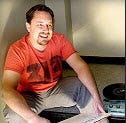Why It's Time To Dump Your Old-School Hiring Practices
Detroit Labs needed to find a new way of hiring employees. The agency, which focuses on full-service mobile, wearable, and Internet hardware, needed candidates who could demonstrate their abilities to think as well as act. The company's co-founder, Nathan Hughes, tells us how old-school hiring practices were completely rewritten, what the new hiring model looks like, and how your organization can follow suit.


12 Ways To Cultivate A Data-Savvy Workforce
12 Ways To Cultivate A Data-Savvy Workforce (Click image for larger view and slideshow.)
When it comes to finding the ideal job candidate to work at our company, expertise in today's specific technology often takes a back seat. Instead, we look to identify candidates who are problem solvers, who can easily adapt, and who can find solutions to next year's challenges.
This kind of approach requires a different, more nuanced attitude than a typical skills-based assessment. To identify the individuals who can change as fast as our business, and who can thrive in our low overhead, decentralized structure, we made several key structural decisions early on. We determined the following:
Hiring would be an open and inclusive process. By encouraging full company participation and public conversation about hiring activities, we hoped to counter -- or at least quickly surface -- issues such as cronyism, favoritism, and unconscious bias, which can plague other hiring processes.
Hiring activities would be goal-oriented, instead of structured on existing industry standards. We abandoned resumes and adopted custom questionnaires tailored to each role, required practical skills interviews for every position, and distributed interview responsibilities across all teams and all roles.
Hiring methodologies would be standardized across all roles, and we would build a record of hiring activities and outcomes that would allow us to use historical data in our hiring decisions.
The best hiring processes combine art and science to produce optimum results. Actively balancing objective methodologies with subjective opinions is an important aspect of the process.
For example, resumes are problematic for us for several reasons. They all look different and contain different content. The impression a well-designed resume may give an interviewer is irrelevant to predicting job success. While it can be influential in the first screen, the content contained in a resume is usually not useful for determining whether a candidate should be brought in for further conversations.
To eliminate resumes from our hiring process, we created a new first step for potential candidate. Each one is asked to complete a role-specific questionnaire, which we call the "Getting to Know You" (GTKY) document.
[How do your hiring plans stack up? Read 10 IT Hiring Plans for Second Half of 2016.]
With a GTKY, we standardized the questions asked of every single candidate for a role, only asking useful and important questions we determined are valuable in assessing candidate suitability. We also worked on developing an understanding of what a good answer to a question looks like.
We are then able to compare candidate applications more uniformly. On the flipside, candidates are able to express themselves uniquely in their answers and communicate their personalities and storytelling abilities in order to shine the best light on themselves and their accomplishments.
When we talk about our hiring process being open and inclusive, we're not merely paying lip service to the idea. In each case, everyone in the company gets one vote, everyone in the company can and should participate in every candidate's hiring process, and no one's vote is more important than any other's vote.
While this seems straightforward, it isn't an easy rule to follow. We've held fast to this rule in the face of special requests to bring founder acquaintances on board. We've held fast, even when a candidate with a unique and specialized skill had an interview-ruining personality flaw. We stuck to the process, even in cases when project manager candidates earned strong support from other project managers, but were panned by the design team.
This one rule has been instrumental in making it difficult, or even impossible, for empire building. It's also eliminated the temptation to abandon our strict hiring standards in the interest of what might be a short-term gain.
In order to fulfill our goal of complete transparency and inclusion in our interview processes, we've intentionally designed our practices to be transferable across company roles and business units and adaptable to unique hiring situations.
The steps for hiring full-time team members are always the same. The candidate submits the GTKY, the team votes "yes" or "no" on the GTKY, and then the votes are tallied. If the candidate passes muster, he or she is invited to in-person interviews.
This first interview assesses a candidate's potential non-technical contributions to Detroit Labs. The interviewers vote, and if there aren't any hard "no" votes, the candidate is invited to participate in a second interview. This second interview assesses the candidate's practical ability to perform the tasks required in the role.
For developers, this may be programming exercises. For designers, this could be a take-home redesign exercise they bring in to pitch and discuss in front of an audience. At that point, we take a final full-pass review of the candidate and decide whether to offer the person a job.
By keeping the steps of the process the same no matter what role is being interviewed for, team members can drop into and out of the process as they see fit for any candidate. They do not have to exclude themselves from interviews that may fall outside their work experience.
If you want to do a second interview for a quality assurance position, but have never done that before, you know it's a practical review of how that candidate could do the QA job. It gives you context to ask for guidance on helping conduct the interview. It also allows us to develop some common language and expectations around the process when uninvolved team members enter the assessment process.
The process scales and adapts for different kinds of activities.
For example, a few times a year we offer an Apprenticeship Program. This paid position generates hundreds of applications for, at most, a dozen jobs. The interview process steps are the same: GTKY, first interview, second interview. But we modify these for screening and assessment of groups versus individuals.
Instead of a candidate meeting with five Detroit Labs employees for a first interview, we organize 10-minute "speed dating" exercises and hand out interview sheets to our interviewers. This allows us to effectively and rapidly interview 30 or 40 applicants, and generate hundreds of countable and comparable scores, in an hour.
The second interview can scale up and become a night with several code challenges assigned to candidate teams, with candidates switching teams every 30 minutes to tackle a new challenge with a new team.
Interviewing and hiring in this manner is not without its challenges. For one, it's impossible to get your friend, who you know would be great and you'd love to work with, a job in Detroit Labs. Everyone has to earn their spot.
Without a wide and active amount of participation across the full team, this process can breed the same problems it attempts to eliminate, such as a hiring manager only being comfortable with hiring people who are just like him or her.
Introducing interviewing to every member of the company requires a lot of training and compliance conversations, so team members understand what is acceptable and unacceptable in interviews.
But, whether looking for seasoned executives or students most likely to excel in a technical apprenticeship, time after time we've seen a structured, team-based, goal-oriented interview process outperform the traditional resume keywords and HR-exclusive hiring systems.
Is this hiring method something you'd try at your organization? As a job candidate, how would you feel about going through this process, as opposed to the typical resume-driven, HR-led practices?
Have you worked to change the hiring procedures in your organization? Let's talk about it in the comments section below.
About the Author
You May Also Like






